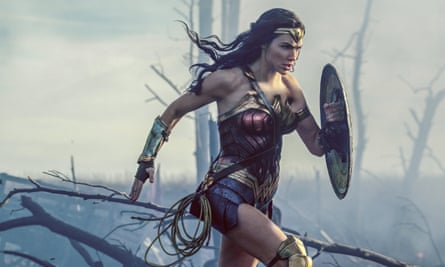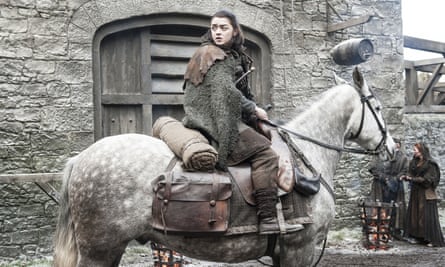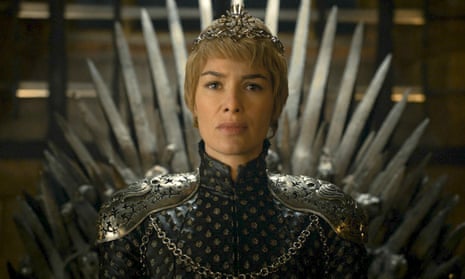Fictions set in alternative realities have enjoyed huge popularity recently, which is perhaps unsurprising in a post-truth world. For the last decade or so, Hollywood appeared to have almost given up producing any film that was not about a comic book superhero fighting a CGI apocalypse: Thor, The Incredible Hulk, Captain America, Iron Man, Superman, Batman, Spider-Man, X-Men, even Ant-Man. Some might wonder if Hollywood was over-compensating: if you want to know what a crisis in popular masculinity looks like, look no further then all those super, super men. Even groups of superheroes, such as Guardians of the Galaxy and the Fantastic Four, rigorously maintained the cultural statutory maximum of 25% female population for any group of leaders. The most realistic part of superhero movies, in fact, is that all the power is generally in the hands of white men; physical laws might get overturned, but not political ones.
Gradually, however, women are pushing their way into the cultural story on terms other than those defined by men. Last summer brought an all-female Ghostbusters, followed this summer by Wonder Woman, who leapt off a cliff and landed squarely, bow drawn, in the centre of this masculine ground. From The Hunger Games to Game of Thrones, audiences have demonstrated a growing appetite for allegorical stories about women with political and moral authority: after more than 50 years and 12 incarnations, even Doctor Who’s Doctor is finally about to become a woman.
Superhero movies are conspicuously fables about power: they are preoccupied with its sources, how to control it, how to justify it. They are the fantasies of superpowers. What made Wonder Woman seem so different, and such a pleasure to so many viewers, was that its story remained focused throughout on the question of women’s relationship to power. Made by and starring women, the film has been a global blockbuster, giving the franchise commercial power, which is the only kind Hollywood pays attention to; but the film itself has provoked a debate over what this allegory of female power is actually saying. Meanwhile, one of the year’s most-discussed television series was also about women and power, albeit in a far less celebratory mode. The Handmaid’s Tale asks explicit questions about what happens in a totalitarian patriarchal society that denies women access to all economic, legal and political rights. And now Game of Thrones, which is equally interested in women and power, has finally premiered its seventh series to its tenterhooked fans.

All of these stories have prompted vigorous arguments about whether they are as feminist as they think they are, or as some viewers thought they were, or ought to be. In such debates there tends to be an implicit acid test, as if Wonder Woman’s golden Lasso of Truth might ascertain the measure of a given story’s feminism. But feminism is not a monolithic creature. It does not submit to identity tests, because neither do the women it speaks to, and about. Less a “movement” than a set of ideas or questions, feminism might be called an attitude, if that didn’t make it sound superficial and flippant, like a lifestyle choice. So call it instead a perspective, a point of view, one defined by the recognition that the world’s power structures are unequal along gendered lines, and that such a situation should be challenged. How, and to what extent – and with what intent – we do so: these are entirely different questions.
Feminism can only be protean: it’s an attempt to think systematically and critically about the relationship to power of half the human race. That’s never going to be easy to encapsulate, even when the heroine is half-divine, the daughter of a god and an Amazon queen. In Wonder Woman’s opening scenes, Diana lives in a feminist island paradise among the Amazons, who neither miss nor desire men – for about 20 minutes, which seems to be as long as Hollywood can manage before a random man arrives and Diana decides she needs to follow him (her reasons are altruistic, but still). Given that she has never even seen a man, much less submitted to male authority, it’s slightly hard to understand why she accepts Steve Trevor’s instructions for so much of the film, including the need to cover up. In part, this is clearly so the film-makers can have some fun sending up the movie makeover: instead of adoring her new dresses, Diana hates them, as the film highlights the absurdity of crinolines, hats and corsets. She prefers her iconic strapless corset and boots, but this choice has provoked its own debate: is this internalised misogyny, in which viewers are encouraged to see Diana as “choosing” to be the fetishised object of male desire, or is it subverting such sexualisation by letting her kick off the constraints of traditional feminine dress and fight as close to naked as a PG-13 rating will permit? Nor is Diana the only powerful woman on screen. Robin Wright, playing her ultra-warrior aunt, steals all the opening scenes, while one of Diana’s antagonists, Doctor Poison, is a female mad scientist bent on vengeful genocide. Doctor Poison has also been hailed as a feminist touch (“even the super-villains are women!”), which might be more persuasive had the film not chosen to emphasise that her evil is motivated by her facial disfigurement. Because if a woman isn’t a beautiful object of desire, life is meaningless, and only Armageddon will do.

Wonder Woman is a cartoon, making it easier to offer a fairytale feminism that will delight some and fall short for others: it all depends on what your vision of female power looks like. In The Handmaid’s Tale, by contrast, there is no such thing, while some of the cast controversially disavowed the word “feminist” in relation to it at all. This struck many observers as odd, not to say apologetic, given how explicitly the series challenges patriarchal power and defends the sexual and political rights of its female characters. Margaret Atwood’s 1985 novel goes so far as to blame, at least in part, second-wave feminists for the totalitarian regime of Gilead, the puritanical, fundamentalist society that overthrows the American government: both Offred’s mother and her friend Moira are radical separatist feminists, asserting that men are unnecessary except for procreation. The tables are turned on them when Gilead reasserts patriarchy, literally colour-coding women in terms of their reproductive and social status: they are either handmaids (red), wives (blue), servants (green) or whores, literalising neo-Puritanical gender categories. Female stereotypes become social iron maidens, instruments of torture and restriction that ensure women can only be defined by one socially imposed aspect of their wholly sexualised identity.
The television series spends less time blaming bad feminism for this outcome, and more time blaming bad patriarchy, which seems rather more reasonable. But it certainly confronts the question of female complicity in patriarchal systems. More than the novel, the series depicts close female relationships (both platonic and sexual), but it also recognises how women might betray each other to protect themselves. So might any woman, the show suggests, under difficult enough circumstances.
Gilead’s enforced piety increasingly becomes a pretext for authoritarianism, as symbolised by the regime’s mandatory greetings: hello and goodbye are replaced by “under His eye” and “blessed be the fruit”. Both phrases serve as constant reminders of the two new social imperatives: masculine surveillance and compulsory reproduction. The secret police are also called “Eyes”, reinforcing the surveillance state, while the monthly rape of the handmaids is euphemised, and aggrandised, as “the Ceremony”. Language is a totalitarian weapon, as all who write about it understand; this is why the women are forbidden from reading and writing. All are also renamed as the possessions of their masters – Offred, Ofglen, Ofwarren – their identities as individual women erased. The female servants aren’t even given patronymics, but merely dismissed as interchangeable “Marthas”, while the women in the brothel are “Jezebels”.

One of the greatest changes between novel and series is made to the character of the Commander’s wife, Serena Joy. In the series she is young and beautiful, a direct sexual rival to Offred; in the novel, she is an older former televangelist celebrity whose insistence that women stay at home is belied by her own political activity, as Atwood plays out the consequences of intergenerational feminist struggles: the sins of the mothers are visited on the daughters. In the television series, by contrast, Serena Joy is the author of her own destruction, a writer who creates the rules that forbid all women, including herself, from reading (a less plausible decision, arguably). In the novel, she is a straightforward hypocrite; in the series, she becomes someone more conflicted about her own choices, a passionate believer at first in the doctrines she creates, of which she becomes a victim. Thus the story becomes less about what feminism should look like, and more an exploration of female complicity and resistance.
Like The Handmaid’s Tale, and unlike Wonder Woman, Game of Thrones also explores women’s relationship to institutional power in a variety of ways – while acknowledging that whatever this relationship might be, it is always categorically gendered. If Wonder Woman is a celebratory story of warrior queens, and The Handmaid’s Tale is a cautionary tale of female enslavement, Game of Thrones offers women who are emperors, slaves and everything in between. It is a world in which women who seem to be pawns have a way of turning out to be queens; but it is also a world that knows queens can always be taken.
Each of the women in Game of Thrones might be said to embody a certain archetypal female experience in relation to power. They cover the spectrum: from the initially conventional femininity of Sansa Stark, submissively learning needlepoint and manipulated by those around her; to her sister Arya, who rejects this sort of femininity in favour of a sword she ironically names “Needle”; to the knight Brienne of Tarth, who is mocked for her lack of femininity but lives like a man in a male-dominated world; to the priestess Melisandre, a fanatic who uses sexual power in the name of religious power; to the heroine Daenerys, whose story arc takes her from rape victim to conquering ruler; to the queen regent Cersei, whose evil is contextualised, if not justified, within a story of rage and thwarted ambition. Yara Greyjoy is a daughter trying to be like a man to please her ferociously misogynist father; Margaery Tyrell is a post-feminist pragmatist, using whatever power she can find to achieve her ends, while her grandmother Olenna (played to the hilt by Diana Rigg) is a cross between Catherine de Medici and the Mother Superior from The Sound of Music, wimple and all. And as the story has evolved, even the most submissive women, like Sansa, are emerging from their violent experiences with a survivor’s sense of strength – and vengeance.

Countless words of journalism have debated whether Game of Thrones is feminist or misogynist; that either supposedly mutually exclusive position can be persuasively argued should suggest something of the show’s complexity. The misogynist case presents the series’ reliance on so-called “sexposition” (plot revelations made amid gratuitous sexual backdrops), its (possibly diminishing) penchant for depictions of rape and violence against women and its refusal (so far) to give any female characters full power. Those who defend the series as feminist argue that the violence against women and the limitations of their power are part of the show’s quasi-realistic exploration of political power in an early modern world. The counter argument points out that if rape is going to be justified on the basis of historical verisimilitude, we should expect to see a lot more rotten teeth and bad hair.
But there’s another way to look at the question. George RR Martin has explicitly identified as feminist; the series’ producers have explicitly not. Certain feminist subplots in the novels have been entirely jettisoned from the series, much to the dismay of some fans. The audience is more or less evenly divided among those who think the series’ gender politics are progressive, those who think they are reactionary, and those who don’t think about them at all.
Watching Game of Thrones play out the storylines of all its varied, fascinating women, in other words, is like watching the culture do battle with its own ideas about women: overt misogyny, internalised misogyny, at least three waves of feminism and post-feminism are all fighting it out before our eyes. It is by no means clear who, or what, will win. What we see is what the struggle over women and power looks like.
Take Cersei Lannister: her actions are often wicked, but she has become one of the most sympathetic and fascinating of Game of Thrones’ characters, giving voice to many of its most feminist utterances. In season one, she tells Sansa Stark that when her brother “was taught to fight, I was taught to smile. He was heir to Casterly Rock, I was sold like a horse.” When Margaery coos that they will be just like sisters, Cersei snaps: “If you ever call me sister again, I’ll have you strangled in your sleep.” When a warrior from another land informs her that in his kingdom, “We don’t hurt little girls”, she replies: “Everywhere in the world, they hurt little girls.”

To complaints that the series is not really feminist because there is no female power that is not compromised in some way, one might respond that this is its most realistic aspect of all. It can also be said of the men. The story recognises that power is dark, corrupting, necessary and impossible. And it allows women the same problematic relationship to power as it does men. There is a saying in Game of Thrones: “valar morghulis”, which means all men must die. But as Queen Daenerys points out to her handmaiden: “Yes, all men must die. But we are not men.”
And it is certainly true that the series’ famed willingness to kill off major characters is overwhelmingly (at least thus far) directed at men. Only three central female characters, as opposed to around 20 central male characters, have died to date by my count. This is a show in which men prove far more expendable than women. Women are exploited but they survive, and they increasingly drive the plot. This makes the story’s energies feel fundamentally feminist: it finds all its women equally interesting, and they all turn out to be forces to be reckoned with. Good, evil, as yet to be morally determined, it doesn’t matter: none of them is negligible, not even the “whores” who are murdered or appear to be exploited early on. They are not all rewarded or liberated or empowered. But they are all significant.
By a similar logic, while there is a tiny bit of hocus-pocus, most of the supernatural power in Game of Thrones is prosthetic, rather than symbolic. Women don’t have internal magical power, because they operate in a recognisably realistic political world – but they can acquire power externally (from dragons, potions, weapons or gods). And any power will do. In one of the best moments of the entire six series so far, Cersei is informed by an enemy that knowledge is power. With a signal, she has her guards put a sword to his throat before correcting him: “Power is power.” Game of Thrones is not a story about dragons. It is a story about power.
One can make the case that all these tales are ultimately feminist, despite occasional shortcomings or even consistent ones, because all their women are fully realised human beings; they all pass the Bechdel test – a film must have two named female characters who talk to each other about something other than a man – with flying colours. In fact, the women in these stories rarely talk about men, except as political or military adversaries, and almost never about love. The ones who do tend not to survive very long.
That said, all these stories do still assume that a woman’s primary emotional drives are toward men, and possibly motherhood. Only The Handmaid’s Tale fully allows for queer female desire, in not one but two major subplots, with sympathetic characters. Wonder Woman starts out in a purely queer environment before ruthlessly stamping out any hint that Diana might have picked up tastes from her fabulously butch upbringing. Game of Thrones doesn’t really, or hasn’t yet, allowed its women to express sexual desire that isn’t normative (unless you count Cersei’s definitely non-normative long-term incestuous relationship with her brother), although Yara Greyjoy might be said to have come out to the audience last year. Queer male desire, by contrast, is taken far more seriously by Game of Thrones: it is a matter of male subjectivity, rather than female objectification, and therefore is sympathetic, characterised, rounded. Queer female desire remains mostly a political gesture, or a passing erotic fantasy for the gratification of the viewer, who is presumed to like looking at female nudity much more than male nudity.
In the end, the fact that all these stories prompt debates about how feminist they are is really the answer to the question, not the question. Feminists don’t share the same answers to complicated questions about women, power, patriarchy, matriarchy, sex and desire. But it took feminism, and feminists, to insist that we should all be asking the questions. Challenging power is itself a liberal, anti-authoritarian act, which means that power’s answer is much less important than the act of posing the question, because that’s what speaking truth to power looks like. The feminist question is how much our culture is prepared to reconcile women and power. And on that question, the jury is very much out.
Series seven of Game of Thrones is out now on Sky Atlantic.

Comments (…)
Sign in or create your Guardian account to join the discussion